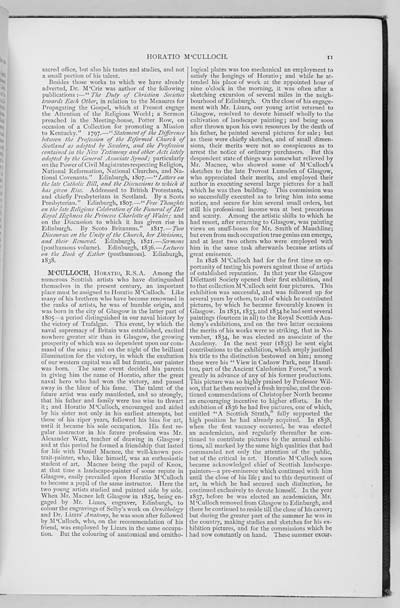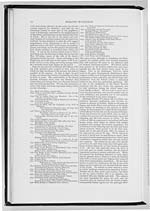II
sacred office, but also his tastes and studies, and not
a small portion of his talent.
Besides those works to which we have already
adverted, Dr. M'Crie was author of the following
publications :�" The Duty of Christian Societies
towards Each Other, in relation to the Measures for
Propagating the Gospel, which at Present engage
the Attention of the Religious World; a Sermon
preached in the Meeting-house, Potter Row, on
occasion of a Collection for promoting a Mission
to Kentucky." 1797.�" Statement of the Difference
between the Profession of the Reformed Church of
Scotland as adopted by Seceders, and the Profession
contained in the New Testimony and other Acts lately
adopted by the General Associate Synod; particularly
on the Power of Civil Magistrates respecting Religion,
National Reformation, National Churches, and Na-
tional Covenants." Edinburgh, 1807.�"Letters on
the late Catholic Bill, and the Discussions to which it
has given Rise. Addressed to British Protestants,
and chiefly Presbyterians in Scotland. By a Scots
Presbyterian." Edinburgh, 1807.�"Free Thoughts
on the late Religious Celebration of the Funeral of Her
Royal Highness the Princess Charlotte of Wales; and
on the Discussion to which it has given rise in
Edinburgh. By Scoto Britannus." 1817. � Two
Discourses on the Unity of the Church, her Divisions,
and their Removal. Edinburgh, 1821.�Sermons
(posthumous volume). Edinburgh, 1836.�Lectures
on the Book of Esther (posthumous). Edinburgh,
1838.
M'CULLOCH, HORATIO, R.S.A. Among the
numerous Scottish artists who have distinguished
themselves in the present century, an important
place must be assigned to Horatio M'Culloch. Like
many of his brethren who have become renowned in
the ranks of artists, he was of humble origin, and
was born in the city of Glasgow in the latter part of
1805�a period distinguished in our naval history by
the victory of Trafalgar. This event, by which the
naval supremacy of Britain was established, excited
nowhere greater stir than in Glasgow, the growing
prosperity of which was so dependent upon our com-
mand of the seas; and on the night of the brilliant
illumination for the victory, in which the exultation
of our western capital was all but frantic, our painter
was born. The same event decided his parents
in giving him the name of Horatio, after the great
naval hero who had won the victory, and passed
away in the blaze of his fame. The talent of the
future artist was early manifested, and so strongly,
that his father and family were too wise to thwart
it; and Horatio M'Culloch, encouraged and aided
by his sister not only in his earliest attempts, but
those of his riper years, followed his bias for art,
until it became his sole occupation. His first re-
gular instructor in his future profession was Mr.
Alexander Watt, teacher of drawing in Glasgow;
and at this period he formed a friendship that lasted
for life with Daniel Macnee, the well-known por-
trait-painter, who, like himself, was an enthusiastic
student of art. Macnee being the pupil of Knox,
at that time a landscape-painter of some repute in
Glasgow, easily prevailed upon Horatio M 'Culloch
to become a pupil of the same instructor. Here the
two young artists studied and painted side by side.
When Mr. Macnee left Glasgow in 1825, being en-
gaged by Mr. Lizars, engraver, Edinburgh, to
colour the engravings of Selby's work on Ornithology
and Dr. Lizars' Anatomy, he was soon after followed
by M'Culloch, who, on the recommendation of his
friend, was employed by Lizars in the same occupa-
tion. But the colouring of anatomical and ornitho-
logical plates was too mechanical an employment to
satisfy the longings of Horatio; and while he at-
tended his place of work at the appointed hour of
nine o'clock in the morning, it was often after a
sketching excursion of several miles in the neigh-
bourhood of Edinburgh. On the close of his engage-
ment with Mr. Lizars, our young artist returned to
Glasgow, resolved to devote himself wholly to the
cultivation of landscape painting; and being soon
after thrown Upon his own resources by the death of
his father, he painted several pictures for sale; but
as these were chiefly sketches, and of small dimen-
sions, their merits were not so conspicuous as to
arrest the notice of ordinary purchasers. But this
despondent state of things was somewhat relieved by
Mr. Macnee, who showed some of M'Culloch's
sketches to the late Provost Lumsden of Glasgow,
who appreciated their merits, and employed their
author in executing several large pictures for a hall
which he was then building. This commission was
so successfully executed as to bring him into some
notice, and secure for him several small orders, but
still his professional income was at best precarious
and scanty. Among the artistic shifts to which he
had resort, after returning to Glasgow, was painting
views on snuff-boxes for Mr. Smith of Mauchline;
but even from such occupation true genius can emerge,
and at least two others who were employed with
him in the same task afterwards became artists of
great eminence.
In 1828 M'Culloch had for the first time an op-
portunity of testing his powers against those of artists
of established reputation. In that year the Glasgow
Dilettanti Society opened their first exhibition, and
to that collection M 'Culloch sent four pictures. This
exhibition was successful, and was followed up for
several years by others, to all of which he contributed
pictures, by which he became favourably known in
Glasgow. In 1831, 1833, and 1834 he had sent several
paintings (fourteen in all) to the Royal Scottish Aca-
demy's exhibitions, and on the two latter occasions
the merits of his works were so striking, that in No-
vember, 1834, he was elected an associate of the
Academy. In the next year (1835) he sent eight
contributions to the exhibition, which amply justified
his title to the distinction bestowed on him; among
these were his " View in Cadzow Park, near Hamil-
ton, part of the Ancient Caledonian Forest," a work
greatly in advance of any of his former productions.
This picture was so highly praised by Professor Wil-
son, that he then received a fresh impulse, and the con-
tinued commendations of Christopher North became
an encouraging incentive to higher efforts. In the
exhibition of 1836 he had five pictures, one of which,
entitled "A Scottish Strath," fully supported the
high position he had already acquired. In 1838,
when the first vacancy occurred, he was elected
an academician, and regularly thereafter he con-
tinued to contribute pictures to the annual exhibi-
tions, all marked by the same high qualities that had
commanded not only the attention of the public,
but of the critical in art. Horatio M 'Culloch soon
became acknowledged chief of Scottish landscape-
painters�a pre-eminence which continued with him
until the close of his life; and to this department of
art, in which he had secured such distinction, he
continued exclusively to devote himself. In the year
1837, before he was elected an academician, Mr.
M'Culloch removed from Glasgow to Edinburgh, and
there he continued to reside till the close of his career;
but during the greater part of the summer he was in
the country, making studies and sketches for his ex-
hibition pictures, and for the commissions which he
had now constantly on hand. These summer excur-

![]() Universal Viewer |
Universal Viewer | ![]() Mirador |
Large image | Transcription
Mirador |
Large image | Transcription
![]()

